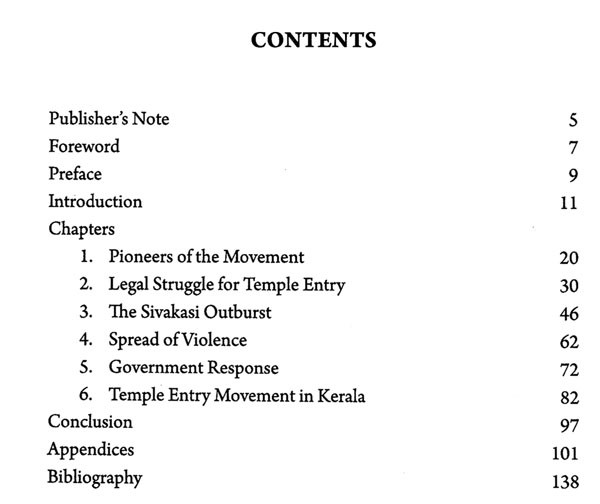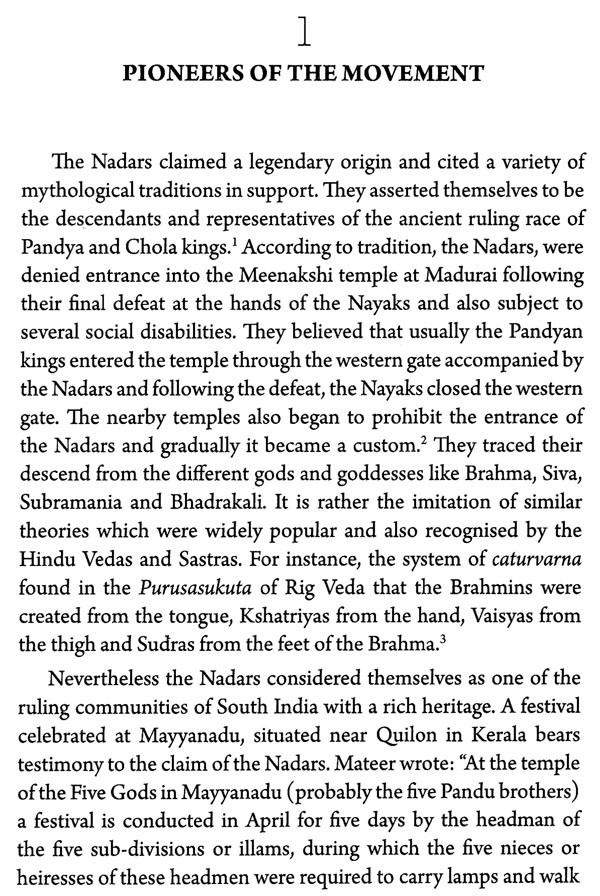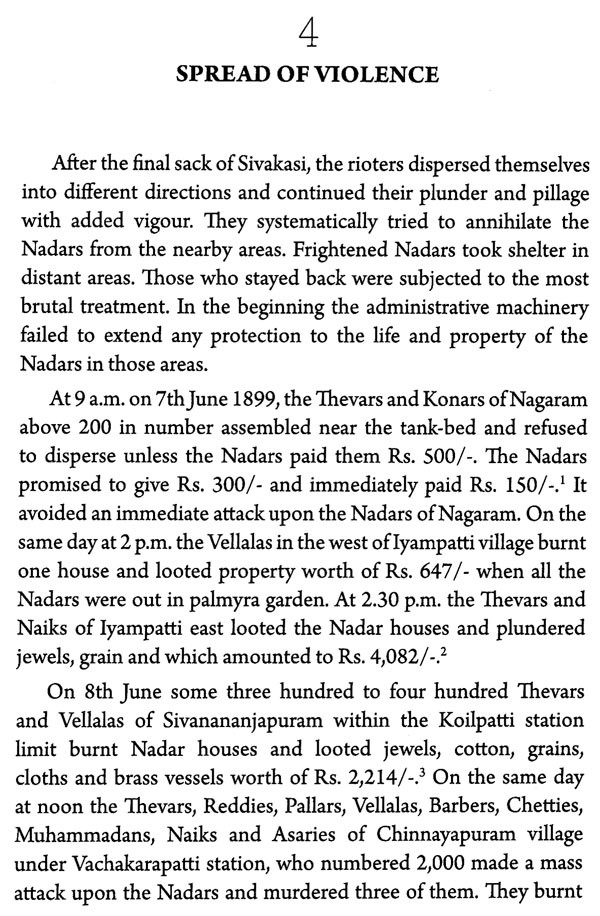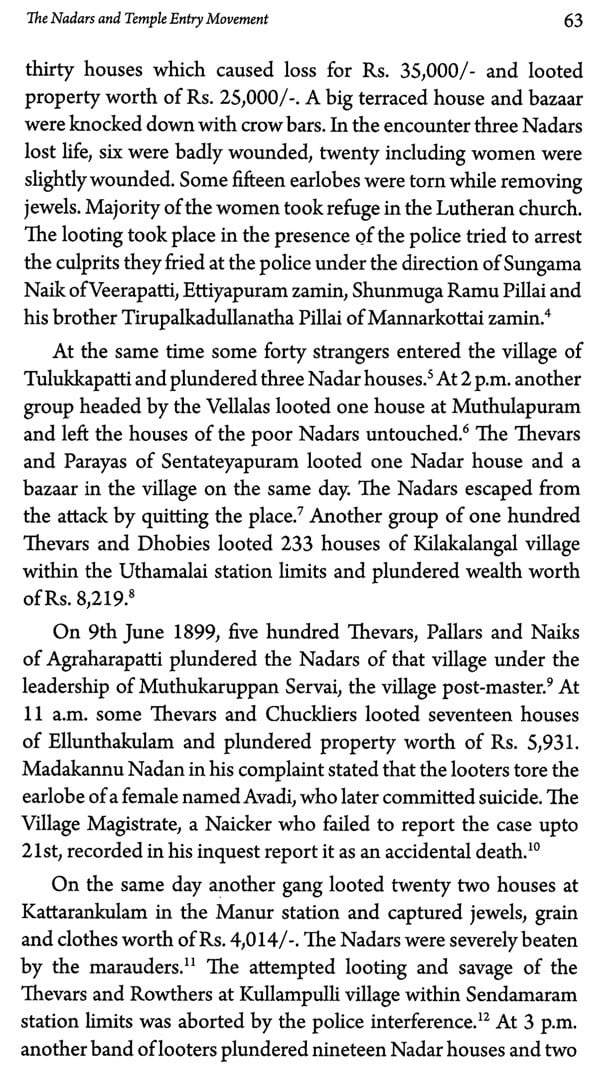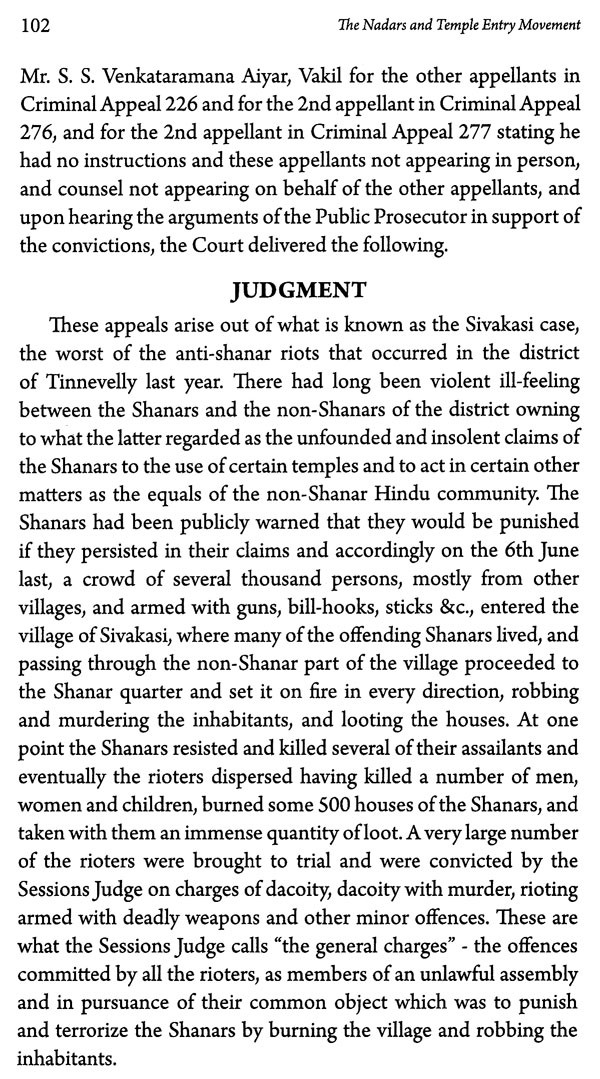
The Nadars and Temple Entry Movement
Book Specification
| Item Code: | NBZ472 |
| Author: | B. Sobhanan |
| Publisher: | Vaikunda Swami International Centre for Study and Research |
| Language: | English |
| Edition: | 2017 |
| Pages: | 144 |
| Cover: | PAPERBACK |
| Other Details | 8.50 X 5.50 inch |
| Weight | 190 gm |
Book Description
History which was mostly confined to the narration of political events has recently changed its trend by giving due emphasis to the life of the common people. Instead of reviewing the growth of civilization from above, attempts are made to analyse the human progress from below. Serious efforts are made by the scholars to narrate socio-religious movements which sprang spontaneously from the lower strata of the society Dr. Sobhanan's work on `The Nadars and Temple Entry Movement' forms a welcome contribution to historical scholarship.
Though much has been written on the socio-religious movements in India, the socio-religious protest which Dr. Sobhanan portrays in this work has not received any attention to long. Among the mass movements the temple entry movement remains without any parallel in the entire history of India, for it symbolised the resolve of the oppressed people to break a religious tradition, that they considered as obnoxious. During the nineteenth century most of the socio-religious movements were piloted by great savants like Raja Ram Mohan Roy, Swami Dayananda Saraswati, Sri Ramakrishna Paramahamsa, Swami Vivekananda and others.
Despite their commanding personality and equalitarian ideas the movements produced little impact on the life of the common people. It was mostly confined among the higher sections and failed to reach the grass root level. But the temple entry agitation represented a movement, that was uninfluenced by any leader or dogma, yet, a virtual crusade aimed at securing for the Nadars a legitimate status in the Hindu Society In the present work, what is significant is that Dr. Sobhanan develops an excellent theory that under changed circumstances, penalisation and victimisation serve as a stimulus to activate the masses and to lead them to self assertion. I wish him success.
The present work, The Nadars and Temple Entry Movement attempts to discuss the socio-religious protest spear-headed by the Nadars of South India against the tyranny of caste system. While some of their brethren escaped the clutches of casteism through conversion to Christianity, the rest of them stood within the Hindu society and fought for their original status in the realm of society. It was not a mere attempt to secure the symbols of status in the form of Sanskritization alone but it represented an organised struggle against religious segregation and social discrimination. It marked the beginning of the struggle for socio-religious equality and civil liberties. By breaking the concept of horizontal movement of the castes, it represented a massive vertical movement which made a gatecrash into Hinduism. The society was virtually divided into two hostile factions like the Plebeians and the Patricians of the Roman Empire. Unlike the valankai-idankai disputes of the early period all the non-caste Hindus united against a particular community and threatened it with total extinction.
Sivakasi, a place situated seventy kilometers south-west of Madurai which is now regarded as mini Japan of India became the scene of a religious crusade. Despite its immediate reverses the temple entry agitation which gathered momentum during the nineteenth century, afterwards converged with the similar movements led by the Indian National Congress and the Self Respect Movement. The study is largely based on primary source material collected from the Tamilnadu Archives, Madras, The archival centres in Kerala and the National Archives of India, New Delhi. The information gathered from the archival repositories is further corroborated with the data collected through field study in the districts of Madurai, Ramanathapuram, Tirunelveli , Kanyakumari and Thiruvananthapuram.
With immense pleasure I dedicate this treatise to the inquisitive readers as a magnum opus of my six years of service in the School of Historical Studies, Madurai Kamaraj University, Madurai. I record my deep gratitude to Prof. K. Rajayyan who always remained a source of inspiration during my career in Madurai-Kamaraj University. I owe a great deal to my most beloved Prof. A. P. Ibrahim Kunju who supervised my doctoral thesis and also corrected the original script. I am equally beholden to Prof. T.K. Ravindran, Former Head of the Department of History, University of Kerala, for his most affectionate encouragement and the invaluable guidance. I am grateful to my learned colleagues, research scholars and other friends for their unfailing enthusiasm and support which enabled me to complete this work. I am grateful to the University Grants Commission, New Delhi for having permitted me to undertake the study as an individual research project with their financial assistance.
I express my sincere thanks to Sri Vishnupuram Chandrasekharan and to the honorable Advisory Committee members of Vaikunda Swami International Centre for Study and Research, Thiruvananthapuram for undertaking the publication of the modified version of the original study titled Temple Entry Movement and the Sivakasi Riots together with an article 'Temple Entry Movement in Kerala' published in the Journal of Kerala Studies by the Departent of History, University of Kerala.
The temples have played a predominant role in the socio-religious life of the people.' The temple assemblies became the makers of rules and regulations to control the life of the people. They remained as the arbiters of social status in the locality. The temples were closely associated with the institution of the caste system. The ancient Tamils were not familiar with the Brahminical form of temples and ceremonies and also the traditional four-fold classification of society based on caturvarna system, expounded by the Aryans. On the other hand they were accustomed to the occupational division of society. It was a harmonious classification for the effective functioning of the society. No distinction was made on the basis of birth and everything was decided on merit, ability and personality.
Untouchability, unapproachability, unseeability and similar customs were unknown to the ancient Tamils. Caste distinctions, disputes and religious dissensions were unheard of The Tirukkural asserts:
To test the greatness of each one and each one's littleness,
The only touchstone is the way in which his deeds he does.2
The crows will not conceal their food but crowing, they would share,
With all their kind. Such men also have wealth and great welfare.'
The men of hill like, highbirth too, will shrink in their size true, Debasing deeds as small as abrus grain should they e'er do.4
The human beings, one and all are equal in their birth,
Through difference in their deeds nature springs difference in their worth.' On the other hand geography had its decisive impact on the Tamil society. Based on the fertility of the soil and its geographical location the lands were divided into five fold natural divisions, viz., Kurichi (hilly region), Palai (barren region), Marutham (cultivable land), Mullai (pastoral land) and Neythal (coastal area). The people who inhabited in these regions were known as hunters (Vettuvars), warriors (Maravars), peasants (Ulavars), cowherds (Aayars) and fishermen (Paradavars) respectively. Within these settlements there were the corporate companionships or brotherhoods of elementary families comprising the members of the clans or gens (who regarded one another as relatives of the common lineage and the kins within the elementry family who were known as okkal keelir , urroor or tamar....in the sense that they were affmal relatives).6 Free social movement existed among the different groups. The early Dravidians were regarded as the direct ancestors of the Tamils, Telugus, Malayalees, Kannadigas and other tribes that occupied the greater part of South India.' The earliest Dravidians were not primitive tribes, but settled people who tilled the soil and raised crops of various kinds e.g. sesamum etc. They were agriculturists by nature.' The Aryans who were familiar with the conventional system of Varnashrama dharma in North India found an entirely different social set up during their migration to South India. Until their migration the people of Tamilagam appeared contented with their respective professions.
They never thought of their superior or inferior status. P. T. Srinivasa Iyengar wrote: "The Brahmins did not succeed in arranging the people of Southern India as members of the four varnas as they did in Northern India. It only led to the confusion of caste and the prevalence of social jealousies that have characterised the life of South India for a thousand five hundred years".9 The Aryans injected the distinctions based on upper and lower status into the body politic of the Tamil society. It might have naturally developed a doubt in the minds of all the professional groups which led to regular confrontations. The Brahmins who formed a microscopic minority emerged as the greatest arbiters and peace makers and extended their counsel to the reigning kings too. By virtue of their spiritual authority, they came to wield considerable influence in the society!° The Brahmin writers on law propounded a model of the caste system which placed them at the top and gave them the privilege of declaring the duties of other castes, including the Kings." In order to buttress their spiritual superiority and temporal welfare, they gerrymandered customs and conventions, administrative and socio-economic systems and brought the entire society under the provisions of their Sastras.
The essential principles of caste system traditionally observed in Hindu society are unchangeable inequality based on birth, the gradation and inequality of vocational professions and restrictions on marriage outside one's own group. In essence one's birth into a particular caste decided the nature and area of his activity. Whether this system is a theoretical division of society, a sociological fiction or a plantonic myth, it worked definitely to the advantage of the Aryan immigrants." Further, the position afforded to the Brahmins by the Tamil kings and the increasing use of Sanskritic forms provided the base for the introduction of the hierarchial organization of caste in Tamil society!' Following the large scale migration of the Aryans to the Tamil country, Tamil society was divided into Brahmins, non-Brahmins and untouchables. The Aryan theory that mankind is divided into four varnas or estate-Brahman, Kshatriya, Vaisya and Sudra was totally alien to the South."
There were no genuine Kshatriyas or Vaisyas in peninsular India and the use of these categories in this area referred only to local castes which had successfully claimed Vaisya or Kshatriya status." The introduction of the inferior and superior status led to a competition among the different communities to receive the sacramental recognition of the Brahmins for their claims.
**Content and Sample Pages**
